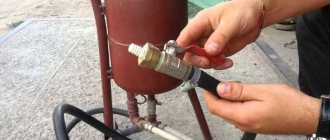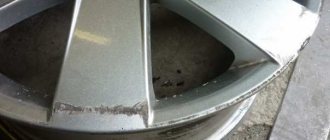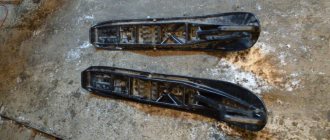Powder painting is a modern technology that allows you to achieve a reliable and durable coating on almost any surface. Application is not particularly difficult if you have the skills, but requires the use of special equipment. The peculiarity of this method is that painting occurs in a dry manner, and a protective layer is formed during subsequent heating.
Everything a beginner powder painter needs to know
Categoriesarticles
03.09.2019
Share this post
It’s difficult for beginners in any business. And painters in the powder industry are no exception. Of course, you can't do without mistakes. But their number can be minimized if you prepare properly. In this article we will share the secrets of powder painting: we will tell you how to properly prepare the surface to be painted, what equipment is needed, and what paint to use - everything a novice painter needs to know for high-quality painting of metal surfaces
Forming a coating
After the powder paint is applied, the product undergoes the next process - coating formation. It consists in straightening the applied composition. As a result, a film forms on the coating, hardening and cooling of the applied layer occurs.
The baking process is carried out using melting chambers or, in the case of doing the coloring yourself, in a conventional oven.
The temperature should be around 2100C. This procedure lasts one quarter of an hour. It is advisable to maintain a stable temperature regime in the paint shop, but there is no special prohibition on opening the oven. After the required time has passed, the product is removed from the chamber and cooled naturally.
It should be remembered that heated metal is softer than in its normal state. Therefore, it should be placed so that it is not accidentally subjected to mechanical stress or deformed.
It should be noted that coatings that are painted with powder paint are of high quality and degree of resistance to mechanical abrasion. This coating will last a long time. In addition, the powders that are used for application to metal and other surfaces themselves have high-quality properties.
As you can see, the DIY dyeing technology is not at all complicated and it is quite possible to do it. The main thing is to follow all the advice while working and not skip the preparatory stages.
Powder coating of wheels (1 video)
Application of powder paint (20 photos)
Safety during work
First of all, you should take care of the form. You need to protect yourself from possible paint getting on your hair, beard or skin. To do this, you should get a hat and clothes with long sleeves and pants. It would be better if it was a special uniform.
You should also avoid inhaling dust. To do this, it is necessary to check the presence of working ventilation systems and be sure to use a respirator to protect the respiratory system. When removing parts after polymerization, wear gloves to avoid getting cut or burned.
Application of powder dyes
The powder is applied by spraying it with a special gun, so the paint particles have a positive charge, the base has a negative charge, this is how the materials adhere, and after fixing the result, it is carried out in a polymerization chamber.
Application of the composition includes the processing of metal, ceramic, glass, MDF, and stone bases. This property makes it possible to use it in the following areas:
- In the mechanical engineering sector;
- For the production of household and office equipment;
- For sports equipment;
- For furniture production;
- For products used in everyday life;
- In construction;
- When creating decorative elements.
The powder is applied by spraying it using a special gun.
Equipment selection
Think about what size items will be painted. Based on this, choose your equipment. Its internal dimensions must correspond to the products. If you can’t decide on the exact size, take the equipment with a reserve.
The polymerization oven can operate on gas or electricity. The first option is more expensive. The most common and affordable option for heating a stove is heating elements.
The spraying chamber can be equipped with a Cyclone recovery system or with filters. The first is better when the colors change no more than once a day. The second is suitable for frequent color changes.
For small and medium painting volumes, it is worth using a tribostatic sprayer. It paints difficult spots and corners well. The electrostatic installation can be used for absolutely any volume. But its price is much more expensive.
The essence of the method
Powder coating technology allows you to obtain the thinnest layer of polymer on the metal, looking integral with the surface. In industrial production, iron is painted using this method. It is used to process mechanical parts, forged products, furniture, entrance doors, and household appliances.
First, the metal is uniformly coated with dry powder particles using a spray gun connected to a voltage source. They are supplied under pressure along with the air flow and are held on the surface due to electrostatic attraction. Next, in special ovens under the influence of elevated temperatures or chemical activators, the paint polymerizes. As a result, a thin but very durable film is formed.
Powder coating of metal products allows you to obtain a coating that is not afraid of even significant temperature changes and exposure to ultraviolet rays. It is not so easy to scratch or damage the polymer film in any other way, even during transportation. And it looks unusually decorative.
Paint selection
Which paint to choose is one of the main questions a painter asks at the beginning of his career.
There are 4 types of powder paint: polyester, epoxy-polyester, epoxy and polyurethane.
The first is intended for external use and painting products exposed to ultraviolet radiation. It can withstand heavy atmospheric loads.
Epoxy-polyester paint is best for painting metal products that will be located indoors.
Epoxy paint should be used for painting materials exposed to chemicals and corrosive environments.
Polyurethane paint is used to protect the surface and give it a certain structure.
Recommendations and safety precautions
Recommendations for carrying out work:
- Painting must be done in a protective suit with a mask and respirator.
- Do not turn on too much air when applying powder. This can lead to accelerated wear of equipment and excessive consumption of the coloring composition.
- It is important to make proper grounding so that the paint lays evenly.
- You cannot mix powders of different colors.
- The powder should be stored in a warm, dry place.
- It is necessary to strictly follow the technology of sintering the powder substance. Any violation will result in visual defects.
There should be good lighting inside the spray booth. This can be achieved using fluorescent lamps. To paint large pieces, you can use a paint gun with a propane torch.
Metal powder coating is a popular technology for applying decorative coatings. It is used in industrial enterprises and at home (if there is a spray booth).
Surface preparation before powder painting
In order to paint products with powder paint of high quality, without defects, the surface must be properly prepared.
You should start with cleaning. Any defects: oil and grease stains, rust, scale, slag, or other things must be removed. This can be done mechanically or with special means designed for each specific case. Then the material must be degreased. You may also need to phosphate or chromate the metal.
Next, the surface is primed. This is necessary to obtain better adhesion (adhesion) of the paint to the metal surface.
If a powder coating painter does not pay due attention to cleaning the product, the paint will not adhere well and you will get defects in the finish coat. And if you degrease it unevenly, the thickness of the coating will decrease on oil stains and increase at their boundaries.
After preparation, you can apply paint. This is done with a special spray gun, which during the spraying process creates an electrostatic charge of the powder mixture.
Technology
The process of painting metal parts with powder compositions can be divided into three stages. These are surface preparation, direct painting (spraying) and consolidation of the result (polymerization).
Preparatory stage
He's the most important. The result of the work depends on how well the surface is prepared for painting. Follow these instructions:
- Take a regular clean cloth and clean the entire surface of the workpiece from dust and dirt.
- Use sandpaper or specialized metal brushes to clean areas with corrosion.
- Degrease the part with a solvent, this will increase the adhesion of the surface to the paint.
- Perform priming. To do this, coat the product with paint based on inorganic substances. Thanks to this layer, the risk of air and moisture penetration under the dried paint is eliminated.
- Apply a layer of sodium compounds and chromium nitrate on top of the part. This process is called passivation. It is carried out so that rust does not appear during the preparation of the part for painting. All the steps are quite simple, so everything can be done at home with your own hands.
- Dry the workpiece in a homemade oven.
Important! If the part has a very complex configuration, is heavily soiled and corroded, soak it in an alkali solution.
Powder coating the part
The next stage after the preparatory stage is the actual coloring. Everything is quite simple here: place the part in the spraying compartment, connect and secure the negative wire from your power source to it. If you turn on our converter and bring a bottle with a metal cap to the part at a distance of 20-30 mm, we will see sparks jumping, this means that the voltage is enough to apply powder paint.
To do this, press on the bottle so that part of the powder, along with the air, is blown out of the holes in the cork. Under the influence of high voltage, paint particles become electrified and stick to the product being painted.
Some of the powder will still spill onto the floor, so lay down some newspaper to catch it later.
Advice! If you plan to achieve fire resistance of a part using painting, buy fire-retardant coatings for metal (Negorin, Polistil and the like).
After applying the powder paint, the process of creating a cured polymer layer begins.
Polymerization
The essence of this process is that the painted part is installed in a special oven. There she is exposed to high temperatures for a certain period of time.
To do this, you will need a self-made oven for polymerizing powder paint. For the process to go smoothly, the following conditions must be met:
- Follow the recommendations developed for each specific paint.
- Ensure that each part is heated evenly.
- Observe the exact polymerization time. When it has expired, remove the part from the chamber and leave it in the open air to cool completely.
The use of this method of painting with powder compositions is ideal for those who like to do everything with their own hands. It takes quite a long time to make a polymerization oven yourself, but there are significant cost savings and a high-quality coating.
Powder paint for metal: properties and characteristics
The main technical characteristics of powder paints include:
- dispersion composition;
- powder flowability;
- bulk density;
- ability to electrify;
- degree of fluidization.
Dispersion composition
The composition of the bulk material includes fine particles that differ in grain size. Grains are usually divided into true particles and aggregates, which are an accumulation of small grains. When applying the material with a spray gun, the true size is not taken into account; to separate large fragments, the technique of sifting the powder through a sieve is used.
For electrostatic application, the grain size is in the range from 10 to 100 microns, but to obtain a thin paint layer the parameter is reduced to a range from 3 to 40 microns. If the technology of powder spraying in a fluidized bed is used, the fraction size increases to 350 microns (comparable to the thickness of the applied enamel layer).
Fine powders allow you to obtain thin coatings, but are prone to uneven settling. Materials with an increased grain size may crumble from the surface, which leads to defects in the paint layer.
Flowability
The flowability of the powder depends on the composition, degree of moisture and particle size. With a reduced parameter, the distribution of paint over the protected surface deteriorates. Powders with grains of a round configuration have increased flowability, but when moisture enters, the characteristics of the material deteriorate. It is allowed to introduce pyrogenic silica or aerosil into the composition of powder paints, which increase flowability. To maintain the parameter declared by the factory, the powder is stored in containers that prevent the powder from being saturated with water vapor.
Bulk density
The density of the material depends on the type of powder and the size of the granules; with the introduction of additional additives (for example, color pigments), the parameter increases by 1.5-2 times. Paint manufacturers are trying to achieve a high density of finely dispersed paint material. When the parameter drops, a deteriorated distribution of grains over the treated surface is observed, on which zones with an insufficient enamel layer are formed.
Electrification ability
Fine powder is electrified during storage, transportation and preparation for application. The charge strength depends on the particle size, the type and chemical composition of additional additives, air and material humidity, and the intensity of mechanical impact.
Electrostatic application technology uses epoxy, polyvinyl buteral or polyethylene paint. As the granule size decreases, the charge retention time increases, but when the air is saturated with moisture, the parameter decreases.
Fluidizing ability
Fluidization of powder materials affects the quality of the paint and varnish coating when using fluidized bed application technology. If the paint contains particles of polyethylene or polypropylene, then the mixture has a low ability to fluidize. A decrease in flowability with simultaneous saturation of the powder with moisture negatively affects the parameter; the application of such materials requires special equipment (for example, installations with a vibration unit and a vortex module).











